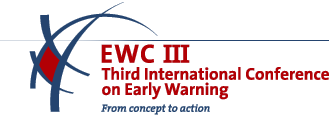
| Home | Sitemap | Legal Notices | Search |

Room E, 14:00 - 15:00
Today, the world has a wealth of knowledge and information on disaster risk reduction at its disposal; the key is sharing and using this in a pro-active way through awareness-raising and educational initiatives so that people can make informed decisions and take action to best protect themselves, their property and their livelihoods during natural hazards.
Governments too, at all levels, have the primary responsibility for protecting their citizens and the communities they live in by making disaster risk reduction a key priority in national development policies and practices. Integrating disaster risk awareness in primary and secondary school curricula and investing in safer school building facilities are important initiatives that require political commitment at the national level.
Education for disaster risk reduction is an interactive process of mutual learning among people and institutions. It encompasses far more than formal education at schools, universities, and in training courses. It involves the use of traditional wisdom and local knowledge to safeguard against natural hazards as well as the active and informed participation of the mass media.
Education is conveyed through experience, established learning arrangements, information technology, staff training, electronic and print media and other means that facilitate the sharing of information and knowledge to citizens, professionals, organizations and policymakers, among a range of other community stakeholders.
Recent disasters clearly show that children have a better chance to survive and to save the lives of their loved ones if they have been informed and educated from an early age about disasters. Disaster risk reduction education at the primary and secondary levels fosters’ awareness and better understanding about the immediate environment in which they and their families live and work.
Education is a crucial means within local communities around the world to communicate, to motivate, and to engage, as much as it is to teach. Awareness and learning about risks and dangers needs to start in early education, continuing through generations.
Numerous opportunities exist whereby educational programmes can be used to promote awareness about hazards, surrounding conditions of vulnerability and community risks. Hands-on, active learning has been shown to be an effective way of involving children and youth in primary earth care and community health activities. This approach can also bring results for disaster risk reduction.
Safe schools and educational buildings, well known as potential “safe havens” against hazards, have proven effective in saving lives; their importance therefore needs to be emphasized. More than 16,000 children died in schools that collapsed during the Pakistan earthquake in October 2005. In addition to seismic hazards, thousands more children are at risk in schools unprotected from high wind, flood, storm surge, landslide, lahar flow, tsunami, and fire. Yet we already possess the collective knowledge of how to develop low cost designs and methods of location and construction that could provide safe schools.
In addition to individual and household decisions, communities, NGOs, teachers’ unions and other institutions of civil society can better use existing knowledge and technologies to participate in and lobby for safe conditions at home and work.
Using knowledge, innovation and education to reduce disaster risk is one of the five priorities of the Hyogo Framework, which was adopted by 168 countries in January 2005. It is the pillar and the essence of our work.